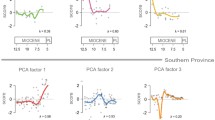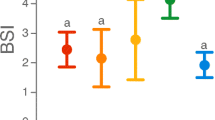Abstract
The patterns of structural transformation in forest rodent communities of Sakhalin have been considered using data from long-term comparative studies of two communities of a somewhat similar species composition. An analysis of species abundance dynamics and dominance structure show that the monodominant community structure in northern Sakhalin is characterized by the absence of interannual rearrangements and high stability, with the overall animal number in rodent communities dependent only on the abundance of the northern red-backed vole (M. rutilus). The community in the southern part of the island could assume one of the two structural types: the monodominant structure with M. rutilus or the gray red-backed vole (M. rufocanus) prevailing or a bidominant structure with both species acting as codominants. The numbers of secondary species vary independently of the numbers of dominant species. Changes in the abundance of M. rutilus and M. rufocanus within the same community are synchronized, whereas the population cycles of these species in the southern and northern communities are not conjugated.


Similar content being viewed by others
REFERENCES
Bashenina, N.V., Puti adaptatsii myshevidnykh gryzunov (The Adaptation Types of Mouse-Like Rodents), Moscow: Nauka, 1977.
Bjørnstad, O.N., Stenseth, N.C., and Saitoh, T., Synchrony and scaling in dynamics of voles and mice in Northern Japan, Ecology, 1999, vol. 80, no. 2, pp. 622–637.
Bobretsov, A.V., Dynamics of the red vole (Clethrionomys rutilus, Rodentia) population for fifty years in the Northern Cis-Ural region, Zool. Zh., 2009, vol. 88, no. 9, pp. 1115–1126.
Getz, L.L., Hofmann, J.E., Oli, M.K., and McGuire, B., Vole population dynamics: influence of whether extremes on stoppage of population growth, Am. Mid. Nat., 2007, vol. 158, no. 2, pp. 461–466.
Gilyarov, A.M., From niche to neutrality in a biological community, Priroda (Moscow, Russ. Fed.), 2007, no. 7, pp. 29–37.
Henttonen, H., McGuire, D., and Hansson, L., Comparisons of amplitude and frequencies (spectral analyses) of density variations in long-term data sets of Clethrionomys species, Ann. Zool. Fen., 1985, vol. 22, no. 3, pp. 221–229.
Haydon, D. and Steen, H., The effect of large- and small-scale random events on the synchrony of metapopulation dynamics: a theoretical analysis, Proc. R. Soc. London, Ser. B, 1997, vol. 264, pp. 1375–1381.
Isaev, A.S., Pal’nikova, E.N., Sukhovol’skii, V.G., and Tarasova, O.V., Dinamika chislennosti lesnykh nasekomykh-fillofagov: modeli i prognozy (Population Dynamics of Phyllophagous Forest Insects: Models and Forecasts), Moscow: KMK, 2015.
Ivanter, E.V., Populyatsionnaya ekologiya melkikh mlekopitayushchikh taezhnogo Severo-zapada SSSR (Population Ecology of Small Mammals in the Northwestern Taiga of the USSR), Leningrad: Nauka, 1975.
Kostenko, V.A. and Burkovsky, O.A., Gryzuny (Rodentia) ostrova Sakhalin (Rodents (Rodentia) of the Sakhalin Island), Vladivostok: Dal’nauka, 2011.
Krebs, C.J. and Myers, J., Population cycles in small mammals, Adv. Ecol. Res., 1974, vol. 8, pp. 267–399.
Krebs, C.J., Kenney, A. J., Gilbert, S., Danell, K., Angerbjörn, A., Erlinge, S., Bromley, R., Shank, C., and Carriere, S., Synchrony in lemmings and voles populations in the Canadian Arctic, Can. J. Zool., 2002, vol. 80, no. 8, pp. 1323–1330.
Liebhold, A., Koenig, W.D., and Bjørnstad, O.N., Spatial synchrony in population dynamics, Ann. Rev. Ecol. Syst., 2004, vol. 35, pp. 467–490.
Litvinov, Yu.N., Soobshchestva i populyatsii melkikh mlekopitayushchikh v ekosistemakh Sibiri (Communities and Small Mammal Populations in Ecosystems of Siberia), Novosibirsk: TsERIS, 2001.
Litvinov, Yu.N., Elements of the spatial organization of communities of small mammals of Siberia, in Soobshchestva i populyatsii zhivotnykh: morfologicheskii i ekologicheskii analiz (Communities and Populations of Animals: Morphological and Ecological Analysis). Novosibirsk: KMK, 2010, pp. 17–48.
McGill, D.J., Etienne, R.S., Gray, J.S., Alonso, D., Anderson, M.J., et al., Species abundance distributions: moving beyond single prediction theories to integration within an ecological framework, Ecol. Lett., 2007, vol. 10, no. 10, pp. 995–1015.
Moran, P.A.P., The statistical analysis of the Canadian lynx cycle. II. Synchronization and meteorology, Aust. J. of Zool., 1953, vol. 1, no. 3, pp. 291–298.
Nesterenko, V.A. Dynamics of rodent population: cyclicity and periodicity, in Dinamika chislennosti gryzunov na Dal’nem Vostoke SSSR i ikh rol’ v ekosistemakh (Population Dynamics of Rodents on the Russian Far East of the USSR and Their Ecosystem Role), Vladivostok: Dal’nevost. Otd., Akad. Nauk SSSR, 1988, pp. 6–7.
Nesterenko, V.A., Loktionova, E.Yu., and Burkovsky, O.A., Dynamics of structure of shrew taxocene in southern Sakhalin, Contemp. Probl. Ecol., 2016, vol. 9, no. 3, pp. 282–289.
Okulova, N.M. and Myskin, A.A., Role of various factors in the population dynamics of the Siberian red vole (Clethrionomys rutilus), Zool. Zh., 1973, vol. 52, no. 12, pp. 1849–1860.
Ripa, J., Analyzing the Moran effect and dispersal: their significance and interaction in synchronous population dynamics, Oikos, 2000, vol. 89, no. 1, pp. 175–187.
Rogovin, K.A., Ecology of communities of related species: approaches and methods of studies by example of terrestrial vertebrates, Zh. Obshch. Biol., 1999, vol. 60, no. 4, pp. 394–413.
Sadykov, O.F. and Benenson, I.Ya., Dinamika chislennosti melkikh mlekopitayushchikh: kontseptsii, gipotezy, modeli (Population Dynamics of Small Mammals: Concepts, Hypothesis, and Models), Moscow: Nauka, 1992.
Surkov, V.S., Ecology of gray rat inhabiting the natural landscapes of Sakhalin Island, Probl. Osobo Opasnykh Infekts., 1973, no. 2 (30), pp. 178–180.
Timofeeva, A.A. and Bykov, Yu.M., Distribution of voles and their impact on forest plantations in the Sakhalin oblast, in Prirodnye resursy Sakhalina, ikh okhrana i ispol’zovanie (Natural Resources of Sakhalin: Protection and Use), Yuzhno-Sakhalinsk, 1975, pp. 137–140.
Tiunov, I.M., Tiunov, M.P., and Sheremet’eva, I.N., Finds of the Mongolian toad (Bufo raddei) and reed vole (Microtus fortis) on the Sakhalin Island, Zool. Zh., 2009, vol. 88, no. 11, pp. 1406–1408.
Zhigal’ski, O.A., Analysis of population dynamics of small mammals, Zool. Zh., 2002, vol. 81, no. 9, pp. 1078–1106.
Zhigalski, O.A. and Kshnyasev, I.A., Population cycles of the bank vole in the range optimum, Russ. J. Ecol., 2000, vol. 31, no. 5, pp. 345–352.
ACKNOWLEDGMENTS
We are grateful to all participants of the expeditions organized by the Zoology Museum of the Far East Federal University as part of monitoring studies commissioned by the Sakhalin Energy Investment Company Ltd., and to S.K. Kholin, research fellow at the Teriology laboratory, Federal Center of Biodiversity Research, Far East Branch, Russian Academy of Sciences, for help with the statistical processing of the data.
Author information
Authors and Affiliations
Corresponding author
Ethics declarations
Conflict of interest. The authors declare that they have no conflict of interest.
Statement on the welfare of animals. All applicable international, national, and/or institutional guidelines for the care and use of animals were followed.
Additional information
Translated by S. Semenova
Rights and permissions
About this article
Cite this article
Nesterenko, V.A., Burkovsky, O.A. Dynamics of Mouselike-Rodent Abundance and Rodent Community Structure in Sakhalin. Contemp. Probl. Ecol. 12, 360–367 (2019). https://doi.org/10.1134/S1995425519040085
Received:
Revised:
Accepted:
Published:
Issue Date:
DOI: https://doi.org/10.1134/S1995425519040085




